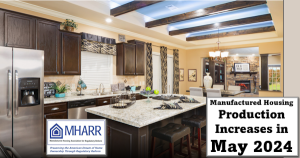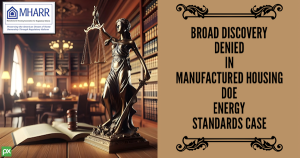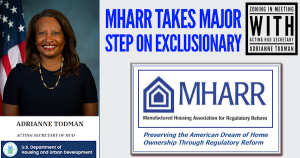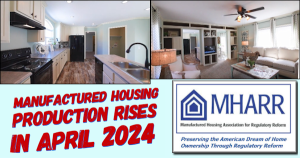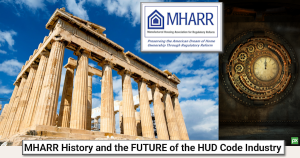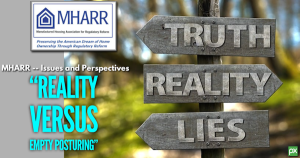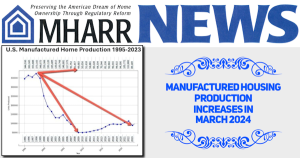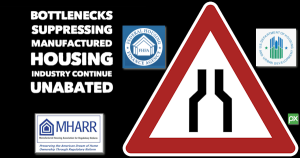HUD Manufactured Housing Consensus Committee (MHCC) Meeting Exposes Looming Battle Over Energy Standards
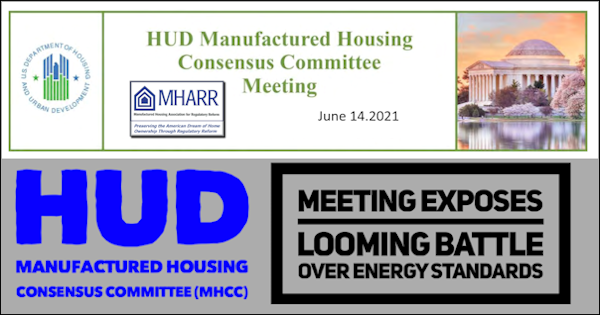
Washington, D.C., June 14, 2021 – The Manufactured Housing Consensus Committee (MHCC) held yet another marathon conference call meeting on June 10, 2021, to take final action on twenty proposed standards and regulatory revisions processed by its various subcommittees in late 2020. The Committee also received a supposed briefing from the U.S. Department of Energy (DOE) regarding impending energy standards for manufactured housing pursuant to the Energy Independence and Security Act of 2007 (EISA).
While various proposals considered by the Committee will ultimately have a substantial impact on the industry and consumers of affordable housing (see below), by far the most significant matter addressed during the meeting concerned the substance and expected procedures relating to the proposal (and adoption) of DOE manufactured housing energy standards.
Industry members will recall that EISA tasked DOE with developing manufactured housing energy standards “in consultation” with HUD and the MHCC, based upon the International Energy Conservation Code (IECC) maintained by the International Code Council (ICC). That directive ultimately led to a tortured, illegitimate and sham DOE standards development process that has now spanned nearly 15 years. The principal feature of that process was a 2014-2016 “negotiated rulemaking” sought by the Manufactured Housing Institute (MHI) and energy special interests, which led to a disastrous 2016 proposed rule. That rule, based on MHARR estimates at the time, would have increased the cost of manufactured homes by at least $4,600 to $5,800, and would have excluded literally millions of Americans from the manufactured housing market (and from homeownership altogether) according to price exclusion metrics developed by the National Association of Home Builders (NAHB). MHARR cast the one and only “no” vote against this proposal in the negotiated rulemaking “Working Group,” (which included multiple MHI members) and has continued to aggressively oppose the adoption of punitive, unnecessary, high-cost “energy” standards promoted by special interests ever since. While MHI, to its credit, subsequently changed position and opposed the 2016 proposed rule, the entire trajectory of this matter could and would have been different if it had never sought or supported the “negotiated rulemaking” process or the negotiated Working Group proposal – a point that could become relevant in any future litigation.
While the Trump Administration subsequently withdrew the illegitimate 2016 DOE proposed rule, there was not sufficient pressure from the entire industry to set aside all DOE activity on this issue. Consequently, when DOE was confronted with a lawsuit by “environmental” activists in 2018 demanding the adoption of manufactured housing energy standards, it agreed to a consent order – notwithstanding aggressive MHARR opposition – which will now require the promulgation of proposed energy standards by August 14, 2021, and the adoption of those new standards in 2022.
Given the mandatory “consultation” required with respect to energy standards by EISA, the “presentation” provided to the MHCC by DOE at the meeting was minimal and dismissive at best, with key details omitted, no materials provided in advance of the meeting, and virtually no substantive engagement with the MHCC. Moreover, when pressed by MHARR’s representative, DOE would not specifically commit to any further engagement at all with the Committee. Instead, Committee members were simply informed that the impending standards will be based on the 2021 version of the IECC. DOE failed to provide, however, any specific information regarding the cost of its proposed rule. And even when those alleged “costs” are provided, that will not be the end of the matter, as EISA requires continuing updates to the standards, based upon future revisions of the IECC. Thus, any initial compliance costs to meet the first set of DOE standards will be just the beginning, as costs will continue to steadily increase – even for those manufacturers who may already be in compliance with (or close to compliance with) the 2021 IECC.
MHARR, in its comments to the Committee, made clear that it will continue to vigorously object to any energy standards that would needlessly increase the cost of manufactured housing, undermine legitimate consumer choice regarding energy features, or exclude millions of lower and moderate-income Americans from the nation’s most affordable source of non-subsidized, inherently affordable homeownership. MHARR also urged the MHCC, in the strongest possible terms:
- To be assertive in dealing with DOE;
- To demand that DOE fully engage with the Committee in order to provide a legitimate opportunity for the MHCC to express its views on the proposed standards; and
- To ensure that the proposed standards do not conflict or interfere with the goals and objectives of federal manufactured housing law.
Further, MHARR reiterated its vehement opposition to any energy standards that are based upon or in any way related to the totally-discredited 2014-2016 “negotiated rulemaking” process or the 2016 DOE proposed rule. In addition, MHARR stated that the 2021 IECC would not and cannot provide a legitimate basis for manufactured housing energy standards because of alleged irregularities with the 2021 IECC voting process as documented by NAHB, and the “governmental consensus process” used to adopt those standards – as described in the March 2021 edition of “MHARR—Issues and Perspectives,” — which gave the final vote on 2021 IECC measures to state and local building officials who have been essentially excluded from the regulation of manufactured housing construction for the past 45 years. Indeed, that entire “governmental consensus process” has now been scrapped for the IECC arising at least in part from the irregularities cited by NAHB.
With a proposed rule expected from DOE by the August 14, 2021 court-ordered deadline, MHARR will continue to take all necessary and appropriate actions to stop the imposition of extreme, illegitimate, discriminatory and never-ending energy standards targeted specifically at manufactured homes and manufactured housing consumers. This includes, but will not be limited to, legal action to prevent the imposition of excessive or unreasonable standards, preferably in conjunction with the entire industry, including MHI and its members, as well as consumer groups.
On other matters considered by the Committee, the MHCC approved significant revisions to the existing Subpart M “On-Site Construction” regulations. The changes, supported and urged by MHARR, would remove duplicative inspection and paperwork requirements (highlighted by MHARR at the time of their adoption) which needlessly increased the cost of on-site work without providing substantive benefits for consumers. Once adopted, these modifications should significantly streamline the “on-site” process, providing both the flexibility and affordability that were originally sought by MHARR and other proponents of these standards.
On another energy-related matter, the MHCC returned to subcommittee a proposal, opposed by MHARR, that would have mandated minimum R-8 insulation (up from R-4) for “supply and return ducts, fittings and crossover duct plenums exposed directly to outside air, such as those ducts located in an unvented or vented attic…” based on a potential conflict with another section of the same standard. MHARR has – and will continue to – oppose this proposal based on numerous grounds set out in its written comments to the MHCC, including cost versus benefit, as well as the need to discourage product suppliers from seeking to “legislate” additional sales and revenue from the industry and consumers.
All other proposals before the Committee were either accepted or rejected in accordance with the recommendations of the various MHCC subcommittees. This included, unfortunately, one proposal opposed by MHARR, which would require air duct testing under prescriptive parameters “similar” to those required by the 2009 IECC. While MHARR objected to this proposal on multiple grounds, including a lack of definitive cost information or a showing of need based on the current standard, it opposed this proposal principally because the HUD Code is based upon the unique nature and affordability of federally-regulated manufactured housing, and should not be conflated with other codes, such as the IECC, which are not designed or developed for manufactured housing and are not under a statutory mandate to balance protection and cost. Accordingly, MHARR will continue to object to this proposal as the regulatory process moves forward.
The Manufactured Housing Association for Regulatory Reform is a Washington, D.C.-based national trade association representing the views and interests of independent producers of federally-regulated manufactured housing.

Washington, D.C., June 14, 2021 – The Manufactured Housing Consensus Committee (MHCC) held yet another marathon conference call meeting on June 10, 2021, to take final action on twenty proposed standards and regulatory revisions processed by its various subcommittees in late 2020. The Committee also received a supposed briefing from the U.S. Department of Energy (DOE) regarding impending energy standards for manufactured housing pursuant to the Energy Independence and Security Act of 2007 (EISA).
While various proposals considered by the Committee will ultimately have a substantial impact on the industry and consumers of affordable housing (see below), by far the most significant matter addressed during the meeting concerned the substance and expected procedures relating to the proposal (and adoption) of DOE manufactured housing energy standards.
Industry members will recall that EISA tasked DOE with developing manufactured housing energy standards “in consultation” with HUD and the MHCC, based upon the International Energy Conservation Code (IECC) maintained by the International Code Council (ICC). That directive ultimately led to a tortured, illegitimate and sham DOE standards development process that has now spanned nearly 15 years. The principal feature of that process was a 2014-2016 “negotiated rulemaking” sought by the Manufactured Housing Institute (MHI) and energy special interests, which led to a disastrous 2016 proposed rule. That rule, based on MHARR estimates at the time, would have increased the cost of manufactured homes by at least $4,600 to $5,800, and would have excluded literally millions of Americans from the manufactured housing market (and from homeownership altogether) according to price exclusion metrics developed by the National Association of Home Builders (NAHB). MHARR cast the one and only “no” vote against this proposal in the negotiated rulemaking “Working Group,” (which included multiple MHI members) and has continued to aggressively oppose the adoption of punitive, unnecessary, high-cost “energy” standards promoted by special interests ever since. While MHI, to its credit, subsequently changed position and opposed the 2016 proposed rule, the entire trajectory of this matter could and would have been different if it had never sought or supported the “negotiated rulemaking” process or the negotiated Working Group proposal – a point that could become relevant in any future litigation.
While the Trump Administration subsequently withdrew the illegitimate 2016 DOE proposed rule, there was not sufficient pressure from the entire industry to set aside all DOE activity on this issue. Consequently, when DOE was confronted with a lawsuit by “environmental” activists in 2018 demanding the adoption of manufactured housing energy standards, it agreed to a consent order – notwithstanding aggressive MHARR opposition – which will now require the promulgation of proposed energy standards by August 14, 2021, and the adoption of those new standards in 2022.
Given the mandatory “consultation” required with respect to energy standards by EISA, the “presentation” provided to the MHCC by DOE at the meeting was minimal and dismissive at best, with key details omitted, no materials provided in advance of the meeting, and virtually no substantive engagement with the MHCC. Moreover, when pressed by MHARR’s representative, DOE would not specifically commit to any further engagement at all with the Committee. Instead, Committee members were simply informed that the impending standards will be based on the 2021 version of the IECC. DOE failed to provide, however, any specific information regarding the cost of its proposed rule. And even when those alleged “costs” are provided, that will not be the end of the matter, as EISA requires continuing updates to the standards, based upon future revisions of the IECC. Thus, any initial compliance costs to meet the first set of DOE standards will be just the beginning, as costs will continue to steadily increase – even for those manufacturers who may already be in compliance with (or close to compliance with) the 2021 IECC.
MHARR, in its comments to the Committee, made clear that it will continue to vigorously object to any energy standards that would needlessly increase the cost of manufactured housing, undermine legitimate consumer choice regarding energy features, or exclude millions of lower and moderate-income Americans from the nation’s most affordable source of non-subsidized, inherently affordable homeownership. MHARR also urged the MHCC, in the strongest possible terms:
- To be assertive in dealing with DOE;
- To demand that DOE fully engage with the Committee in order to provide a legitimate opportunity for the MHCC to express its views on the proposed standards; and
- To ensure that the proposed standards do not conflict or interfere with the goals and objectives of federal manufactured housing law.
Further, MHARR reiterated its vehement opposition to any energy standards that are based upon or in any way related to the totally-discredited 2014-2016 “negotiated rulemaking” process or the 2016 DOE proposed rule. In addition, MHARR stated that the 2021 IECC would not and cannot provide a legitimate basis for manufactured housing energy standards because of alleged irregularities with the 2021 IECC voting process as documented by NAHB, and the “governmental consensus process” used to adopt those standards – as described in the March 2021 edition of “MHARR—Issues and Perspectives,” — which gave the final vote on 2021 IECC measures to state and local building officials who have been essentially excluded from the regulation of manufactured housing construction for the past 45 years. Indeed, that entire “governmental consensus process” has now been scrapped for the IECC arising at least in part from the irregularities cited by NAHB.
With a proposed rule expected from DOE by the August 14, 2021 court-ordered deadline, MHARR will continue to take all necessary and appropriate actions to stop the imposition of extreme, illegitimate, discriminatory and never-ending energy standards targeted specifically at manufactured homes and manufactured housing consumers. This includes, but will not be limited to, legal action to prevent the imposition of excessive or unreasonable standards, preferably in conjunction with the entire industry, including MHI and its members, as well as consumer groups.
On other matters considered by the Committee, the MHCC approved significant revisions to the existing Subpart M “On-Site Construction” regulations. The changes, supported and urged by MHARR, would remove duplicative inspection and paperwork requirements (highlighted by MHARR at the time of their adoption) which needlessly increased the cost of on-site work without providing substantive benefits for consumers. Once adopted, these modifications should significantly streamline the “on-site” process, providing both the flexibility and affordability that were originally sought by MHARR and other proponents of these standards.
On another energy-related matter, the MHCC returned to subcommittee a proposal, opposed by MHARR, that would have mandated minimum R-8 insulation (up from R-4) for “supply and return ducts, fittings and crossover duct plenums exposed directly to outside air, such as those ducts located in an unvented or vented attic…” based on a potential conflict with another section of the same standard. MHARR has – and will continue to – oppose this proposal based on numerous grounds set out in its written comments to the MHCC, including cost versus benefit, as well as the need to discourage product suppliers from seeking to “legislate” additional sales and revenue from the industry and consumers.
All other proposals before the Committee were either accepted or rejected in accordance with the recommendations of the various MHCC subcommittees. This included, unfortunately, one proposal opposed by MHARR, which would require air duct testing under prescriptive parameters “similar” to those required by the 2009 IECC. While MHARR objected to this proposal on multiple grounds, including a lack of definitive cost information or a showing of need based on the current standard, it opposed this proposal principally because the HUD Code is based upon the unique nature and affordability of federally-regulated manufactured housing, and should not be conflated with other codes, such as the IECC, which are not designed or developed for manufactured housing and are not under a statutory mandate to balance protection and cost. Accordingly, MHARR will continue to object to this proposal as the regulatory process moves forward.
The Manufactured Housing Association for Regulatory Reform is a Washington, D.C.-based national trade association representing the views and interests of independent producers of federally-regulated manufactured housing.



